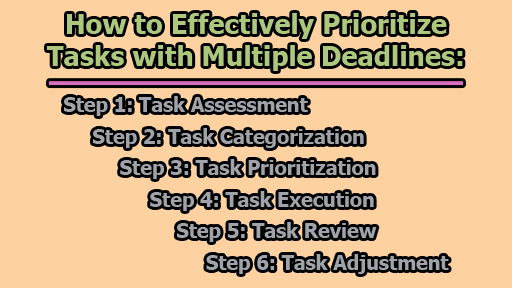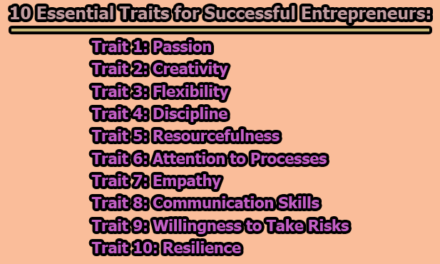How to Effectively Prioritize Tasks with Multiple Deadlines:
In today’s fast-paced work environment, managing multiple tasks with looming deadlines is a common challenge faced by professionals across various industries. Effectively prioritizing the following tasks is crucial for ensuring productivity, meeting deadlines, and achieving overall success. In this article, we will explore how to effectively prioritize tasks with multiple deadlines, breaking down the process into six key steps that guide individuals in optimizing their workload management.
Step 1: Task Assessment:
The journey towards effective task prioritization begins with a meticulous assessment of all pending assignments. This initial step is fundamental as it lays the groundwork for informed decision-making throughout the entire process. Task assessment involves capturing crucial details about each task, such as deadlines, estimated time, difficulty level, dependencies, impact, and stakeholders. This information can be organized using various tools, including task management software, spreadsheets, or a simple to-do list.
The key purpose of task assessment is to gain a holistic understanding of the workload at hand. It enables individuals to grasp the intricacies of each task, identify potential challenges, and recognize dependencies that may impact the overall workflow. By documenting these details, professionals can avoid overlooking critical aspects of their assignments, ensuring a comprehensive and detailed overview.
Additionally, the task assessment phase sets the stage for transparency and collaboration. Stakeholders, team members, and managers can benefit from a clear depiction of the workload, facilitating better communication and alignment of expectations. This step, therefore, acts as the foundation upon which subsequent prioritization decisions are made, ultimately contributing to a more organized and efficient approach to task management.
Step 2: Task Categorization:
Once tasks have been thoroughly assessed, the next logical step is to categorize them based on their urgency and importance. This step is often facilitated by utilizing frameworks such as the Eisenhower matrix, a popular tool that classifies tasks into four quadrants: do first, schedule, delegate, and eliminate.
Tasks falling into the “do first” quadrant are those that are both urgent and important. These require immediate attention and prioritization, emphasizing their critical nature. On the other hand, tasks categorized as “schedule” are important but not urgent, allowing for a planned approach and allocation of time in the future. “Delegate” tasks are urgent but may not be personally crucial; these are suitable for assigning to others within the team. Finally, tasks in the “eliminate” quadrant are neither urgent nor important, suggesting that they may be dropped or minimized to optimize focus on more critical assignments.
Categorizing tasks in this manner provides a visual representation of their priority levels, assisting individuals in making strategic decisions about where to direct their immediate attention and where to allocate resources for future endeavors. It sets the stage for a structured and organized approach to task prioritization.
Step 3: Task Prioritization:
Following the categorization of tasks, the third step involves prioritizing them within each category. Various prioritization methods can be employed, each offering a unique perspective on how to rank tasks based on their significance. One such method is the MoSCoW technique, which assigns priority levels of “must have,” “should have,” “could have,” or “won’t have” to each task.
Tasks categorized as “must have” are non-negotiable and take precedence over others. “Should have” tasks are important but may allow for some flexibility in timing, while “could have” tasks are desirable but not crucial. “Won’t have” tasks are deemed least important and can be postponed or eliminated.
Another approach is the Pareto principle, which posits that 80% of results come from 20% of efforts. In the context of task prioritization, this implies focusing on the most impactful tasks that contribute significantly to overall goals. The ABCDE method assigns each task a letter from A to E, with A being the highest priority and E the lowest.
Step 4: Task Execution:
With tasks assessed, categorized, and prioritized, the fourth step involves the actual execution of the planned activities. Successful task execution requires the application of best practices aimed at optimizing productivity and performance. Setting SMART goals is a fundamental strategy – goals that are Specific, Measurable, Achievable, Relevant, and Time-bound provide a clear framework for task accomplishment.
Breaking down larger tasks into smaller, more manageable subtasks is another key strategy. This not only makes the workload seem less overwhelming but also allows for better tracking of progress. Batching similar tasks together can be highly efficient, as it minimizes context-switching and fosters a state of flow. Avoiding multitasking and minimizing distractions are crucial aspects of effective execution, ensuring that full attention is dedicated to each task at hand.
Communication is equally vital during the execution phase. Keeping stakeholders, team members, and managers informed about progress and potential challenges helps maintain transparency and facilitates a collaborative working environment. Regular updates and clear communication of expectations contribute to a smoother workflow.
Taking breaks and incorporating rewards into the execution process is an often overlooked but essential aspect of maintaining productivity. Short breaks can help in maintaining focus and preventing burnout, while rewards serve as positive reinforcement, motivating individuals to consistently perform at their best. By incorporating these best practices, individuals can navigate the execution phase with efficiency and poise.
Step 5: Task Review:
After the completion of tasks, the fifth step involves a comprehensive review of the results and feedback received. This step is crucial for evaluating the effectiveness of the prioritization and execution processes. Professionals should assess whether they met deadlines, delivered quality work, achieved their goals, and satisfied stakeholders.
Reflection is a key component of the review process. Identifying what went well, what went wrong, and what could be improved provides valuable insights for continuous improvement. Celebrating successes, acknowledging mistakes, and applying learnings to future tasks contribute to a culture of growth and development within the professional sphere.
The review phase also involves seeking feedback from stakeholders and team members. Understanding their perspectives and incorporating constructive feedback enhances the overall quality of work. This iterative feedback loop ensures that individuals remain adaptable and open to improvement, fostering a mindset of continuous learning.
Step 6: Task Adjustment:
The final step in effective task management involves adjustment based on changes or new information. Task lists should be reviewed regularly, and updates should be made accordingly. This step requires flexibility and adaptability to cope with unexpected events, urgent requests, shifting deadlines, or feedback loops.
Re-prioritization may be necessary based on changing circumstances, and it is crucial to communicate these changes to stakeholders, team members, and managers. Seeking support and feedback in times of uncertainty or increased workload is a proactive approach that contributes to successful adaptation.
Therefore, the ability to adjust tasks and priorities is a dynamic skill that ensures individuals can navigate the ever-changing landscape of their professional responsibilities. Regular reviews and adjustments contribute to a proactive and resilient approach to task management, allowing professionals to maintain high levels of efficiency even in the face of uncertainty.
In conclusion, effectively managing tasks with multiple deadlines requires a systematic and organized approach. The six-step process outlined in this article provides a comprehensive guide for professionals to assess, categorize, prioritize, execute, review, and adjust their tasks. By implementing these strategies, individuals can navigate the complexities of workload management, optimize productivity, and achieve success in their professional endeavors.

Library Lecturer at Nurul Amin Degree College










